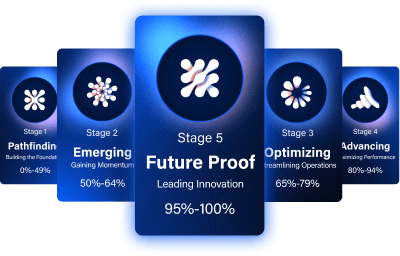To help define what it means to be a “digitally driven firm,” let’s go back in time…
In March 2020, most businesses transitioned to remote work overnight.
Some accounting firms made the transition look easy. These were the digitally-driven firms. They were the early adopters of digital solutions; they were already using cloud hosting to securely transfer data, access information and collaborate.
The firm technology these practices had in place helped them seamlessly transition to 100% remote work.
And though we’re coming out of the pandemic, remote work isn’t going anywhere.
When the pandemic does mercifully recede, offices will begin to populate once again, but only as an option for employees—not an imperative.
2022 State of Accounting Firms Trends Report, CaseWare®
So how can your practice become a digitally driven firm? Below are several tips to help you get there.
How to become a digitally-driven firm
1. Host your apps and software in the cloud
To be a truly digitally-driven firm, you must use a cloud-hosting portal to host your applications, software, data and physical documents.
Cloud portals provide a secure environment where accountants, firm personnel and clients can work and communicate.
Think of cloud portals like digital, secured file drawers on the internet that also have the capacity to automate or integrate PBC lists, status dashboards, client reminders and much more.
Working with your files only from a cloud portal:
- Minimizes transcription errors.
- Saves travel time.
- Ensures anyone with the correct permissions has access to these files, regardless of location.
- Creates a copy or backup in case of accidental loss or deletion.
- Limits their exposure and protects them from theft and cyber attacks.
Digitize your files by uploading them to a cloud portal, then begin accessing them from your accounting, tax, document and workflow tools. Next, we’ll dive deeper into how digitally driven firms handle documents within their cloud portals.
2. Handle documents electronically
Does this sound familiar? “I know that document was in the stack I sent you.”
Because digitally driven firms handle all documents electronically, there’s no question of whether the client sent that document to you or not. If it’s not in the cloud-hosting environment’s file share or in the specific application you’ve directed the client to upload to, it hasn’t been uploaded.
And speaking of directing clients to upload to a specific location: To keep your clients happy, teach them how to digitally file documents and the benefits of doing so.
Here are three good tips to keep in mind when educating clients about your new digital process:
- When showing clients how to scan and upload documents to the portal, explain that their return will be securely delivered the same way.
- Tell your clients that they will receive an electronic notification when their return is completed.
- Explain that digital documents and communication will save your clients on the cost of paper, ink, postage and the time it takes to physically mail documents. For a small business, that’s a savings of more than $4,000 annually.
The Postal Service currently collects approximately $338 per month in postage on average for small businesses or close to $4,000 annually.
With education, all firm members and clients will understand how to upload and share documents electronically. However, a change to a longstanding process doesn’t happen overnight. Sometimes clients will forget to share their documents with you electronically. That’s why it’s important to determine a process for when clients share physical documents, too.
Pro tip: When clients share physical documents, create a digital copy immediately
Creating a digital copy of a physical document has many benefits, including:
- Immediate, continued access: Preparers and reviewers have immediate access to the documents from any location at any time. Plus, digital documents don’t need to be returned to the client at the end of the engagement.
- Time savings: Transfer hard copies from person to person or via snail mail if your team works from multiple locations.
- Lower costs: Save on paper, stamps, ink and envelopes.
- Custody and audit trail: Putting one department or person in charge of scanning files as they come through the door ensures an audit trail per document. From the moment that file is scanned and digitized, you can see 1) who’s touched it, 2) what changes have been made, and 3) when the changes were made.
- Improved security: Ensure all documents are secured by uploading them to a cloud-hosting environment, where they will be protected by bank-level security and automatic backups.
We’ve spoken a lot about the importance of digital documents and working from cloud-hosting environments to store those documents.
Now, we’re going to review a few types of software that further improve tax processes, work in cloud-hosting environments and get firms one step closer to becoming digitally driven.
3. Use engagement software with integrated signature tools
An easy process to digitize is how you deliver engagement files.
With the right engagement software and cloud hosting, teams can review files from anywhere, while benefiting from the myriad of advantages cloud hosting provides:
Implementing cloud technology on engagement software was game-changing for me when I was a practicing accountant. It allowed me to manage multiple teams more efficiently, by enabling me to review engagement files and efficiently answer team member questions, while at a different location. I was able to access the engagement file from a separate location and clearly understand the issue the team was facing in real time.
Sarah Coulson, Industry Strategist, CaseWare®
Accounting software vendors with integrated signature tools
4. Integrate tax processes into one application
Workflow tools integrate all steps of the tax process into a single application and are available to all firm personnel.
Project workflow capabilities can be added to tax or practice management software, but the most comprehensive solutions are designed specifically for accounting firm workflows.
Accounting and tax workflow tools
- CCH Axcess Workflow (formerly XCM)
- CCH Workstream
- Thomson Reuters FirmFlow
- DocIt Workflow
- OfficeTools
5. Import a tax trial balance from the binder package into the return
An often-overlooked opportunity to streamline tax returns is the importing of the tax trial balance from the binder package into the return, which 66% of the CPAFMA DDF survey respondents were utilizing.
Only 66% of survey respondents import tax trial balances from the binder package to the return.
Once tax codes and groupings are designated, the information can be directly imported into the return with time savings rolled over from year to year.
Applications and software that can import tax trial balances
6. Use online invoicing and payment services
There’s a significant amount of manual handling in most firms’ billing and collections processes.
Today’s time and billing systems can easily generate a digital invoice that can either be emailed directly to the client and their controller or accounts payable person, or placed in the portal as an attachment with the return.
Firms can include digital payment instructions such as ACH and online credit card payments, which can integrate payment links embedded in these invoices. Some online payment services (CPACharge, QuickFee, Thomson Reuters Kotapay) can also be integrated with the firm’s practice management application for direct import to the appropriate client account, rather than manually re-keying.
Ready to become a digitally driven firm?
Firms that continue to adopt and promote entirely digital files and processes will be at a competitive advantage for the many reasons mentioned above.
For more information on becoming a digitally driven firm, evaluate our accounting and tax cloud-hosting packages and app directory today.


